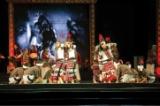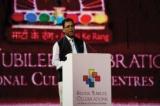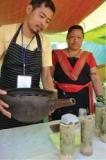Archives
Northeast Rules in National Cultural Carnival
The festival, titled ‘Matti Ke Rang’, was inaugurated by Prime Minister Manmohan Singh in the presence of AICC President Sonia Gandhi and Minister for Culture Kumari Selja.
Integration Through the Arts
The ZCCs are these cultural centres which were conceived by former Prime Minister late Rajiv Gandhi in a bid to promote national integration by disseminating the vibrancy of India’s culture to its people in the rural areas. He was one of the first to realise that the diversity of our country is ‘a practical reality and not just a theoretical concept’, and that culture is the most suitable tool that can be used as the base for national integration for culture has the capacity to reach across to people, cutting across barriers of time, space, language, values and traditions.
| The Arts should not only be a mirror of contemporary life but should function as an instrument of social change. There could be no better instrument than the medium of music, dance and drama to bring about national integration. |
It is pertinent to remember the words he spoke during the setting up of the ZCCs: “The performing arts reach across all communities, all language barriers, and have a unique role to spread the values that have inherited. Participating in the performing arts is an osmotic process of building values, awareness, familiarity and respect and even reverence for different strands in the rich tapestry of our civilisation and our heritage. So integrating our country must be seen as one of the functions of the performing arts today.”
The Zonal Cultural Centres (ZCCs) were set up 25 years ago in second-tier towns of the country so as to reach the people in the grassroots. Since inception, these centres have been working towards the objectives to preserve, innovate and promote the projections and dissemination of folk arts, cutting across regional cultural borders and bringing about unity through culture. The seven overlapping zones comprising the Zonal Cultural Centres have promoted, cross-promoted and created opportunities for cultural exposure and awareness among the people of different states and regions.
With the philosophical implication that the number 7 has, the seven ZCCs epitomizes a celebration of cosmic time and space. The seven ZCCs are North Zone Cultural Centre, Patiala, South Zone Cultural Centre, Thanjavur, Eastern Zonal Cultural Centre, Kolkata, West Zone Cultural Centre, Udaipur, North East Zone Cultural Centre, Dimapur, North Central Zone Cultural Centre, Allahabad, South Central Zone Cultural Centre, Nagpur.
 The North East Zone Cultural Centre, which encompasses the seven sister states of the north east and Sikkim is based in Dimapur. With a competent staff led by its dynamic Director Som Kamei, the Centre has been organizing a number of intra and inter-cultural events in all the states of the country and even abroad.
The North East Zone Cultural Centre, which encompasses the seven sister states of the north east and Sikkim is based in Dimapur. With a competent staff led by its dynamic Director Som Kamei, the Centre has been organizing a number of intra and inter-cultural events in all the states of the country and even abroad.
The fact that the ZCCs have completed 25 years warranted a mega celebration, which resulted in the Silver Jubilee celebrations in Panchkula as it was.
Culture Unbarred
When I say the Silver Jubillee celebrations were a gala affair, I mean every word I say. For the choreographed performances of the cultural event at the main stage, which were based on more than 15 singing forms and 12 martial arts were performed by more than 1000 performing artists alone! During the day there were more than 30 art form performances being simultaneously enacted within seven mini villages of all the seven Zonal Cultural Centres of India. Large crowds thronged the courtyard of mini villages of the Seven Zonal Centres to purchase exquisite traditional items from various parts of the country. But the major highlight of the entire event was the food streets where the special cuisine of each zone was laid out for the visitors. Offering traditional and sumptuous food, the food area was undoubtedly the most sought after area during the entire celebrations. The master craftsmen who were ferried from the different nooks and crannies to set up their stalls also had brisk sales.
 A number of popular and eminent arts were performed across all four days of the celebrations. On the concluding day ceremony the audience was able to witness the entire spectrum of the country’s culture on a common platform. The choreographed dance presentation included the famed Chanting form of Sikkim, Thumchen from Jammu & Kashmir, Sankh Vadan from Orissa, Algoza from Rajasthan, Baul Kirtan from West Bengal, Bhortal from Assam, Jangam Gayan from Haryana, Bhakan from Jammu & Kashmir, Dhadhi from Punjab, Tati singers from Nagaland, Nirgun Bhajan from Rajasthan, Kajri Gayan from Uttar Pradesh, Golparia musical instruments from Assam and performance of Langa Mangniar singers from Rajasthan.
A number of popular and eminent arts were performed across all four days of the celebrations. On the concluding day ceremony the audience was able to witness the entire spectrum of the country’s culture on a common platform. The choreographed dance presentation included the famed Chanting form of Sikkim, Thumchen from Jammu & Kashmir, Sankh Vadan from Orissa, Algoza from Rajasthan, Baul Kirtan from West Bengal, Bhortal from Assam, Jangam Gayan from Haryana, Bhakan from Jammu & Kashmir, Dhadhi from Punjab, Tati singers from Nagaland, Nirgun Bhajan from Rajasthan, Kajri Gayan from Uttar Pradesh, Golparia musical instruments from Assam and performance of Langa Mangniar singers from Rajasthan.
An exemplary martial arts display was also a major highlight of the celebrations as martial warriors from various parts of the country performed together on stage in perfect synchrony.
Northeast India Rules
| Thanks to the able leadership of its Chairman Nagaland Governor Nikhil Kumar and its Director Som Kamei, the Silver Jubilee celebrations had begun in the twin cities of Dimapur and Jorhat last month itself. |
North east India was beautifully represented by the North East Zone Cultural Centre, which had facilitated the travel and performance of a more than 2,000-member troupe for the festivities. Thanks to the able leadership of its Chairman Nagaland Governor Nikhil Kumar and its Director Som Kamei, the Silver Jubilee celebrations had begun in the twin cities of Dimapur and Jorhat last month itself.
A special northeastern folk music and dance presentation, depicting the rich and unique cultural milieu of the region was also held on the concluding day of the festival. Tribal music and dance forms were displayed in the event, which was inaugurated by Hon’ble Shri Paban Singh Ghatowar, Minister of State (Independent Charge) for Development of North Eastern Region (DoNER).
Food is culture too!
Besides the art camps, folk dance, handloom and handicraft exhibition and music performances and cultural exchange events, a major highlight of the three day celebration in Panchkula was the food festival which sought to display the culture of the varied zones of the country through the prism of their cuisine. Judging from the response of the people, northeastern food, which has been labelled exotic by many, was a clear favourite.
 The food street behind each mini village offered a range of traditional cuisines prepared by chefs who were brought in from their zones especially for the celebrations. The North East Zone Culture Centre had also set up stalls for each of the eight states. While the Assamese food stall offered traditional lip smacking delicacies like black rice pudding, chicken coconut rice and rice beer, the Manipuri food stall offered unheard of but very delectable cuisine like eromba, sinju, proautti, pakoda and natuga. The Naga food stall was also very popular for its famed chicken with bamboo shoot whereas the Sikkim food stall offered its range of special noodles, momos and other Tibetan dishes. Assamese rice powder gur ladoo and til gur ladddoo were also much sought after by the visitors from outside.
The food street behind each mini village offered a range of traditional cuisines prepared by chefs who were brought in from their zones especially for the celebrations. The North East Zone Culture Centre had also set up stalls for each of the eight states. While the Assamese food stall offered traditional lip smacking delicacies like black rice pudding, chicken coconut rice and rice beer, the Manipuri food stall offered unheard of but very delectable cuisine like eromba, sinju, proautti, pakoda and natuga. The Naga food stall was also very popular for its famed chicken with bamboo shoot whereas the Sikkim food stall offered its range of special noodles, momos and other Tibetan dishes. Assamese rice powder gur ladoo and til gur ladddoo were also much sought after by the visitors from outside.
Apart from the north east, the other Zones also laid down the best of their fares. While one at the Allahabad food stall couldn’t resist the temptation of tasting the awadhi dum aaloo, jalebi and the chaat papdi, the Maharashtra food stall had jawar ki roti and baingan ka bharta. The popular Hyderabad food stall also served a variety of non vegetarian and vegetarian biryani varieties.
Art Should be an Instrument of Change
The mega Silver Jubille celebrations of the ZCCs concluded amidst a lot of gaiety and merriment on the 16th of April. As artists from various parts of the country came together on a common platform to project the diversity of the country, one could remember the words of late Zakir Hussain: “The Arts should not only be a mirror of contemporary life but should function as an instrument of social change. There could be no better instrument than the medium of music, dance and drama to bring about national integration.”
For any organization, 25 years is a long time to look back in retrospect. As curtains came down on the celebration in the august presence of Hon’ble Union Minister of Culture Kumari Selja and Sh. H.E Shivraj V. Patil, the resolve of the people manning the ZCCs to usher in ‘development through culture’ further deepened.

